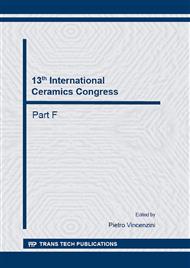[1]
M. Bøjer, P.A. Jensen, F. Frandsen, K. Dam-Johansen, OH. Madsen, L Kasper, Alkali/Chloride release during refuse incineration on a grate: Full-scale experimental findings, Fuel Processing Technology, 89 5 (2008) 528-539.
DOI: 10.1016/j.fuproc.2007.10.003
Google Scholar
[2]
D.W. McKee, D. Chatterji, Corrosion of silicon carbide in gases and alkaline slag, J. Am. Ceram. Soc., 59.
Google Scholar
[9]
(1976) 9 10.
Google Scholar
[3]
N.S. Jacobson, Corrosion of silicon-based ceramics in combustion Environments, J. Am. Ceram. Soc., 76.
Google Scholar
[1]
(1993) 3 - 28.
Google Scholar
[4]
H. Matsuda, S. Ozawa, K. Naruse, K. Ito, Y. Kojima and T. Yanase, Kinetics of HCl emission from inorganic chlorides in simulated municipal wastes incineration conditions, Chemical Engineering Science, 60.
DOI: 10.1016/j.ces.2004.07.131
Google Scholar
[2]
(2005) 545-552.
Google Scholar
[5]
H.P. Nielsen; F.J. Frandsen; K. Dam-Johansen; L.L. Baxter, The implications of chlorine-associated corrosion on the operation of biomass-fired boilers, Progress in Energy and Combustion Science, 26.
DOI: 10.1016/s0360-1285(00)00003-4
Google Scholar
[3]
(2000) 283-298.
Google Scholar
[6]
S. Nathan, Jacobson and James L. Smialek, Hot corrosion of sintered α-SiC at 1000°C, J. Am. Ceram. Soc, 68.
Google Scholar
[8]
(1985) 432-439.
Google Scholar
[7]
M.K. Ferber, J. Ogle, V.J. Tennery, T. Henson, Characterization of corrosion mechanisms occurring in a sintered SiC exposed to basic coal slags, ,J. Am. Ceram. Soc, 68.
DOI: 10.1111/j.1151-2916.1985.tb15296.x
Google Scholar
[4]
191-197 (1985) 191-197.
Google Scholar
[8]
A.D. Lawrence and J. Bu, The reactions between Ca-based solids and gases representative of those found in a fluidized-bed incinerator – Chemical engineering Science, 55 (200) 6129-6137.
DOI: 10.1016/s0009-2509(00)00213-x
Google Scholar
[9]
J.M. Brossard, P. Prigent, J. Poirier, High temperature corrosion of oxide bonded silicon carbide refractory lining in WtE facilities, Journal of the European Ceramic Society, 33.
DOI: 10.1016/j.jeurceramsoc.2013.02.015
Google Scholar
[11]
(2013) 2065-(2072).
Google Scholar
[10]
P. Prigent, M.L. Bouchetou, J. Poirier, E. De Bilbao, E. Blond, Corrosion of SiC refractories by molten salts in Solid Waste-to-Energy facilities, Ceramics International 38.
DOI: 10.1016/j.ceramint.2012.04.007
Google Scholar
[7]
(2012) 5643-5649.
Google Scholar
[11]
E. de Bilbao, P. Prigent, C. Mehdi-Souzani, M.L. Bouchetou, N. Schmitt, J. Poirier, E. Blond, Measurement of the volume expansion of SiC refractories induced by molten salt corrosion, Journal of Ceramic Science and Technology, 4.
DOI: 10.1002/9781118837009.ch11
Google Scholar
[4]
(2013) 207-212.
Google Scholar
[12]
E. Blond, N. Schmitt, F. Hild, P. Blumenfeld, J. Poirier, Modeling of high temperature asymmetric creep behavior of ceramics, Journal of European Ceramic Society, 25 (2005) 1819 – 1827.
DOI: 10.1016/j.jeurceramsoc.2004.06.004
Google Scholar
[13]
E. Blond, N. Schmitt, F. Hild, P. Blumenfeld, J. Poirier, Effect of slag impregnation on thermal degradations in refractories, Journal of American Ceramic Society, 90.
DOI: 10.1111/j.1551-2916.2006.01348.x
Google Scholar
[1]
(2007) 154-162.
Google Scholar
[14]
M. Thorley,R. Banks, Kinetics and mechanism of oxidation of silicon nitride bonded silicon carbide ceramic. Journal of Thermal Analysis and Calorimetry, 42 (1994) 811-822.
DOI: 10.1007/bf02546752
Google Scholar
[15]
H. Flood, T. Förland, The Acidic and Basic Properties of Oxides. Acta Chemica Scandinavica 1 (1947) 592-604.
DOI: 10.3891/acta.chem.scand.01-0592
Google Scholar
[16]
T. Katsutoshi , M. Kawano, T. Kobayashi, Effect of cations on crystallization of amorphous silica, II. Kagoshima Daigaku Rigakubu Kiyo, Chikagu seibutsugaku 26 (1993) 1-16.
Google Scholar


